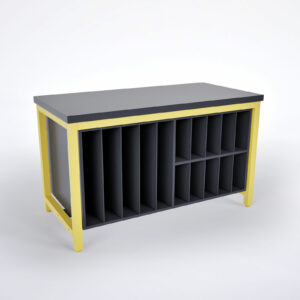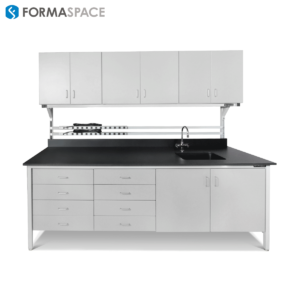In a world where we can connect our smart phones and tablets to the information superhighway, what is the way forward for libraries? Will our local library be unable to compete with online books and close down like so many shuttered brick-and-mortar bookstores before it? Or will library designs evolve (and flourish) to meet the 21st Century needs of the communities they serve?
“What’s dangerous is not to evolve.”
– Jeff Bezos
Let’s take a moment to let the words of Amazon* founder, Jeff Bezos, sink in: we have to evolve or die.
(*Full disclosure: Amazon is a long-time Formaspace customer.)
And librarians know it.
Acquiring, cataloging, and archiving printed materials for use by researchers, historians, writers, students, and teachers, as well as striving members of our local communities has been a core function of the world’s libraries for centuries.
Yet, in internet time, change happens fast.
In just a few short years, nearly every published work has now become available at our fingertips – ranging from classic Greek plays and the collected works of Shakespeare to the newest medical reference journals and the headlines in today’s newspapers.
As a result, today’s librarians have had to come to terms with the existential question: what is the future of libraries when the focus has moved away from the printed word?
Top among New Library Trends: Librarians Teaching Information Literacy
Historically it’s been the role of librarians to manage scarce resources and make them accessible to the communities they serve. But in many ways, today‘s librarians are facing the opposite problem: the inherent scarcity of printed books and periodicals has turned into a flood of information available directly from the internet. And this newfound abundance has created a new set of challenges for librarians.
For example, as we all know, not all online reference materials are reputable, e.g. based on solid facts supported by evidence. Yet many students writing their first term papers are ill-prepared to search online for trustworthy resources beyond what’s available on Wikipedia.
That’s where many librarians now see their new primary role: to step in and help teach Information Literacy to students, researchers, and the public at large, all of whom need help to become more adept at accessing and interpreting online information.
As a result, many librarians are now teaching new skills to their patrons, such as:
• How to access a variety of online databases to perform deeper searches.
• How to identify valid information sources, based on facts supported by empirical evidence.
• How to analyze and critique the available information resources found online and use them appropriately with proper referencing and without copywriting infringement.
Technology Is Transforming Library Designs from Static Book Repositories to Collaborative Learning Environments
Second among new library trends is a re-imagining of the physical library design itself.
In response to the lower demand for physical books and publication by users (who are increasingly accessing materials online), many libraries have begun to reduce the inventory of printed materials they keep in circulation.
As a result, floor space once dedicated to stacks of books is now available for new uses.
But what should these newly created vacant spaces be used for?
Many libraries are seizing on this opportunity to create new collaborative learning environments.
For example, officials at University of California at Berkeley have converted the top two floors of the Moffitt Library into an open, collaborative environment for learning, kitted out with flexible furniture that can be moved around by students to create ad hoc study groups as well as glass walls that serve as high-tech whiteboards.

Sounds like a high-tech startup office doesn’t it?
Not surprisingly, the library renovation was designed by Gensler, the San Francisco-based architect who’s been responsible for creating work environments for many of the Bay Area’s innovative startup software companies.
In creating collaborative learning environments, libraries are coming into alignment with the newest trends in office design that we’ve written about before, such as collaborative working methods favored by Millennials.*
(*Millennials, and the generations that follow them, have been taught from an early age to work on projects in teams, making them much more comfortable working as members of a group, especially compared with their more “independent minded” Baby Boomer or Gen-X peers.)
Build It and They Will Come: The Rise of Maker Spaces in Library Facilities
Third among emerging library trends is the incorporation of creative Maker Spaces in libraries.* These Maker Space facilities allow patrons to use equipment to create their own projects, ranging from wearable electronics to walking robots.
(*For more information on how to design a Maker Space for your library, read our article Makerspace 101: Building a Makerspace for Library and Education Professionals.)
Some may argue Maker Spaces are beyond the scope (and budgets) of many local library systems. Clearly, the cost to kit out a Maker Space is comparatively expensive (even for those with deep pockets.) But that’s where a library can step in, much like they did starting back in the 1800s when “Mechanics’ Institutes” helped provide free technical education materials to the public in the UK and USA.
So, while providing the public with access to 3D printers, laser cutters, CNC machining tools, or sewing and quilting machines may seem expensive at first, when the relatively high cost of Maker Space equipment is spread out over a wider community, it becomes a much more reasonable investment in the future.
By offering Maker Space facilities, today’s libraries are also supporting the promotion of the STEM (Science Technology Engineering and Mathematics) curriculum in our schools, by providing students with important opportunities for hands-on learning.
In fact, providing access to maker technology can be seen as a logical extension of the other technology services that today’s libraries provide, such as:
• Computers with internet access as well as content creation software, such as Adobe Photoshop.
• Technology training classes (especially for kids and seniors), as well as online classes (such as GED test preparation.)
• Assistance with writing resumes and conducting job searches.
From STEM to STEAM: Adding Art to the Library Equation
The fourth emerging trend that’s defining the future of libraries is the adoption of ambitious, creative arts programs designed to involve the entire the community, a type of outreach that’s especially important when it comes to inspiring our children.
(This trend is also part of a greater movement to reintroduce the arts into technology-focused STEM student curricula, by adding the letter A to change the acronym STEM into STEAM.)
In the vanguard of this movement is the Library Incubator Project, which views itself as the equivalent of an entrepreneurial “business incubator” for the entire creative process.
A quick visit to the Library Incubator Project website will inspire you, with a wide range of art projects taking place at libraries around the country, including:
• Books to Boogie, which pairs books readings with dance performances.
• Iowa City Public Library’s Local Music Project, which promotes recordings by local artists.
• Los Angeles Public Library’s LA Made cultural program series, which features lectures and performances from leaders in the world of art, theater, dance, music, and literature.
When It Comes to New Library Design, What Is Your Favorite?
Recently, the Knight Foundation conducted a worldwide contest to answer the question: How can libraries best serve 21st-century information needs?
The 2016 Knight News Challenge received over 600 proposals. The 14 finalist winners will each receive a share of the $1.6 million in grant money awarded.
Among the ideas that attracted our attention were:
• A system to help Wikipedia editors become more proficient at writing accurate entries.
• A project in Norway, designed exclusively for children ages 5 – 10 that provides a unique playground space with classes in cooking, drama, 3D printing, Lego building, and more.
• A “petting zoo for electronics” that allows patrons to try out different electronic devices in the comfort of a library – without being burdened by the undue sales pressure that typically happens in a store.
Talk to Formaspace for New Ways to Approach Library Design
There’s a lot of creative, unconventional thinking in today’s modern library design, from the updated Rijksmuseum Library in Amsterdam, to the Bibliotheca Alexandrina, which is built in honor of the famed Library of Alexandria in Egypt.

Want to know more?
Turn to Formaspace for free consultation services.
As your library needs change, we can help you transform your existing facility to keep up with the latest library and public furniture design trends.
Whether you are installing a Maker Space, a collaborative learning environment or building a community center, we have the expertise to not only advise you but also create the custom furniture that will make your project a success – made-to-order by furniture craftsmen here at our factory headquarters in Austin, Texas.
Talk to us today. Fill out the quick form below to get started.








